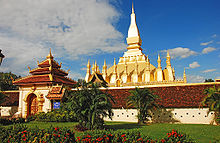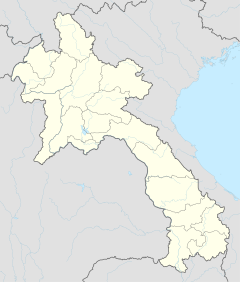Pha That Luang
| Pha That Luang | |
|---|---|
Lao: ທາດຫຼວງ or ພຣະທາດຫລວງ | |
 Pha That Luang | |
| Religion | |
| Affiliation | Buddhism |
| Location | |
| Location | Vientiane |
| Country | Laos |
| Geographic coordinates | 17°58′34.20″N 102°38′03.30″E / 17.9761667°N 102.6342500°E |
Pha That Luang (Lao: ທາດຫຼວງ or ພຣະທາດຫລວງ; pronounced [pʰā.tʰâːt lǔa̯ŋ] "Great Stupa") is a large, gold-covered Buddhist stupa in the centre of the city of Vientiane, capital of Laos.[1] Since its initial establishment, suggested to be in the 3rd century AD, the stupa has undergone several reconstructions, as recently as the 1930s, due to foreign invasions of the area. It is generally regarded as the most important national monument in Laos as well as a national symbol.[2]
History
[edit]
Buddhist missionaries from the Mauryan Empire are believed to have been sent by Emperor Ashoka, including Bury Chan or Praya Chanthabury Pasithisak and five Arahanta monks, who brought a sacred relic (believed to be the breastbone) of Buddha and enshrined it into the stupa in the 3rd century BC.[2] The structure was rebuilt in the 13th century as a Khmer temple, which fell into ruin.
In the mid-16th century, King Setthathirat relocated his capital from Luang Prabang to Vientiane and ordered the construction of the temple in 1566.[3] It was constructed about 4 km from the centre of Vientiane, at the end of Pha That Luang Road, and named accordingly.[2] The bases had a length of 69 metres each, and the stupa was 45 metres high, surrounded by 30 smaller stupas.[2]
In 1641, a Dutch envoy of the Dutch East India Company, Gerrit van Wuysthoff, visited Vientiane and was received by King Sourigna Vongsa at the temple, reportedly in a magnificent ceremony. He wrote that he was particularly impressed by the "enormous pyramid...and the top was covered with gold leaf weighing about a thousand pounds".[4] The stupa was repeatedly plundered by the Burmese, Siamese, and Chinese.[3]
Pha That Luang was destroyed by the Thai invasion in 1828, which left it heavily damaged and abandoned. It was not until 1900 that the French restored it to its original design, based on detailed drawings from 1867 by the French architect and explorer Louis Delaporte.[3] However, the first attempt to restore it was unsuccessful, and it had to be redesigned and then reconstructed in the 1930s.[3] During the Franco-Thai War, Pha That Luang was heavily damaged during a Thai air raid. After the end of World War II, it was reconstructed.
Architecture
[edit]The architecture of the building includes many references to Lao culture and identity, and so has become a symbol of Lao nationalism.
The first level is 223 by 226 feet (68 by 69 metres); the second is 157 feet (48 metres) along each side; and the third level is 98 feet (30 metres) along each side.[3] From ground to pinnacle, Pha That Luang is 147.6 feet (45.0 metres) high.[3]
Only the pinnacle is covered in real gold; the remainder of the stupa is painted a gold color.
The area around Pha That Luang is now gated, to keep out traffic. Previously, visitors could drive around the whole complex. The encircling walls are roughly 279 feet (85 metres) long on each side and contain a large number of Lao and Khmer sculptures, including one of Jayavarman VII.[3]
Gallery
[edit]-
Pha That Luang stupa
-
View of the stupa from inside the temple
-
The national symbol of Laos at sunset
-
Nāga inside the temple
-
That Luang Festival (2010)
-
Thatluang Festival (2010)
-
That Luang stupa at night
-
That Luang
-
King Jayavarman VII of the Khmer Empire
-
Naga Pagoda of west Pha That Luang, October 2006
See also
[edit]References
[edit]- ^ Foreman, William (28 December 2004). "Laos: A day in Vientiane is full of temples, colonial architecture and surprises". USA Today / AP. Retrieved 22 May 2010.
- ^ a b c d "Half Day Tour in Vientiane". Lasi Global. 1 May 2009. Retrieved 26 September 2009.
- ^ a b c d e f g "Pha That Luang (built 1566, reconstructed 1930)". Asian Historical Architecture. Retrieved 26 September 2009.
- ^ Cummings, J.; Burke, A (1994). Lonely Planet Country Guides:Laos. Lonely Planet. p. 70. ISBN 1-74104-086-8.
External links
[edit]![]() Media related to Pha That Luang, Vientiane at Wikimedia Commons
Media related to Pha That Luang, Vientiane at Wikimedia Commons












